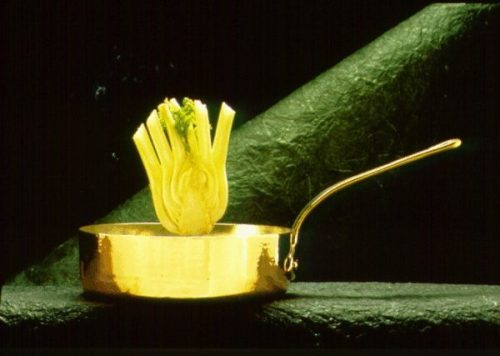
MARTINO ROSSI
"Cheese pie with herbs"

| Piglia altretanto cascio frescho como è dito di sopra et pistalo molto bene, et habi quindici o sidici bianchi d'ova con un quarto vel circha di bon lacte; et pigliarai de le vietole in bona quantità, cioè per la maiore parte, et de la maiorana pocha, salvia assai, menta pocha, petrosillo assai. Et tutte queste herbe pistarai insieme molto bene premendone fora il sucho, et passandolo per la stamegna. Il qual sucho mettirai insieme con le cose sopra ditte mettendo con esse meza libra di bono strutto, overo butiro frescho; et prendirai poche foglie di petrosillo, et pochissime foglie de maiorana, et con un coltello le tagliarai et le battirai più menute che sia possibile, et macinarale molto bene nel mortale incorporandole con le sopra ditte cose, agiongendovi meza oncia di zenzevero biancho, et otto oncie di zuccharo. Et fa' che tutta questa composizione sia ben mescolata in uno vaso, il quale metterai sopra le brascie lontano da la fiamma del focho, menando continuamente col cocchiaro, o altro intrumento atto a questo, tanto che ti para che se incomenci a pigliare a modo d'un brodetto. Et facto questo haverai apparecchiata in la padella una pasta sottile, et mettirali dentro queste cose sopra ditte, cioè pieno, daendoli il focho temperatamente ad ascio di sotto et di sopra. Et quando ti pare che sia presa abastanza, cavala fore, et metteli di sopra del zuccharo fino et dell'acqua rosata. Et simile torta o herbolata che vogliamo dire, quanto è più verde, tanto è migliore, et mostra più bella. |
soft cheese egg whites milk Swiss chard marjoram sage mint parsley lard (butter) ginger sugar sweet dough or pie dough rose water |
Get the same quantity of soft cheese that was specified in the preceding recipe [a pound and a half for "white cake"] and cream it well. Now, prepare fifteen or sixteen egg whites and about a quart of milk. Get a generous quantity of Swiss chard, which must exceed the quantity of the other herbs; that is, enough sage and parsley, and not much mint and marjoram. Crush all these herbs in the mortar so that the juice comes out, and run the mixture through a sieve. Add the juice to the preceding ingredients together with half a pound of lard or butter. Get a few more leaves of parsley and just a little marjoram, chop them with a knife, gently crush them in the mortar and add them to the other ingredients. Add half an ounce of ginger and eight ounces of sugar. Amalgamate the mixture well in a pot and cook it far away from the flame. Stir constantly with a spoon or other suitable utensil and cook until it begins to thicken and becomes as dense as a soup. After completing these steps, line a pan with thin dough, fill it with the mixture you have prepared and heat gently both above and below. When it seems like it has thickened enough, remove it from the fire and pour the sugar and rose water on top. The greener this cake (which is called "erbolata") is, the better impression it makes when served. |